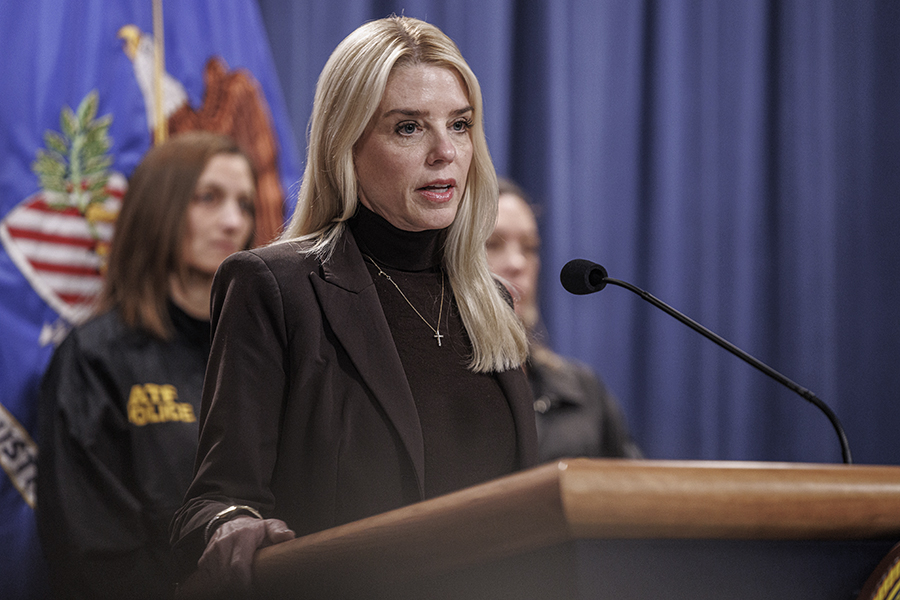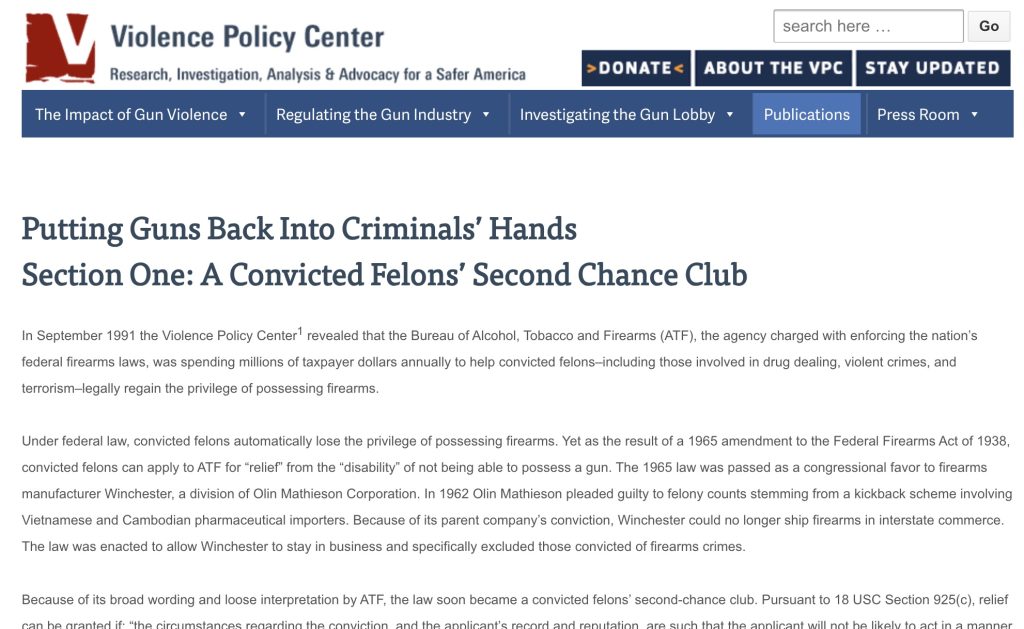
On March 20, the U.S. Department of Justice published an interim final rule entitled, Withdrawing the Attorney General’s Delegation of Authority. That bland title belies the historic nature of the measure, which is aimed at reviving a provision of federal law that could, for the first time since 1992, allow federally prohibited persons to petition for restoration of their Second Amendment rights. The rule took immediate effect on March 20, but DOJ will accept comments on the measure up to June 18.
Federal law – codified at 18 U.S.C. 922(g) – imposes a ban on firearm possession and receipt for 13 categories of individuals based on certain underlying convictions or events. For most categories, the ban is presumptively permanent. The most prominent of these categories includes those who have been “convicted in any court of … a crime punishable by imprisonment for a term exceeding one year.” The crimes, under ATF’s interpretation of the statute, can include not just felonies but misdemeanors punishable by more than two years imprisonment.
Theoretically, the ban doesn’t count with respect to convictions that have been “expunged … or set aside or for which a person has been pardoned or has had civil rights restored.” Federal case law, however, has severely narrowed the effectiveness of most state expungements or rights restoration procedures in removing federal firearm “disabilities.” Thus, a person could have had his or her Second Amendment rights restored at the state level, but still be federally ineligible. This would effectively prevent a person from buying a firearm from a gun shop or from having a concealed carry permit or license.
It is extremely difficult, moreover, for most ordinary folks to get the governor of their state or the president interested in hearing their pardon requests.
Nevertheless, the Gun Control Act offered another option codified at 18 U.S.C. 925(c), a petition to “the Attorney General for relief from the disabilities imposed by Federal laws[.]” The Attorney General is empowered to “grant such relief if it is established to his satisfaction that the circumstances regarding the disability, and the applicant’s record and reputation, are such that the applicant will not be likely to act in a manner dangerous to public safety and that the granting of the relief would not be contrary to the public interest.”
That program had formerly been administered by ATF under a delegation of authority from the Attorney General’s office. ATF data from 1981 to 1991 show that 13,790 “relief” investigations were conducted during that time. Of these, 5,598 cases (about 40.6%) were approved and 3,498 (about 25.4%) were denied. The remaining applicants either abandoned their applications, weren’t disqualified in the first place, were ineligible under state law (state eligibility was required by ATF), or were on parole or probation.
In 1992, however, Congress passed an appropriations rider defunding ATF’s administration of the program. This was due to concerns over the amount of resources ATF was diverting from its other law enforcement and regulatory programs to process the petitions, as well as lobbying by anti-gun groups, who claimed that restorations endangered public safety. Of course, these were the same groups that believed possession of firearms by any private individual posed a public safety hazard. Nevertheless, that appropriations rider has been renewed every year since, effectively foreclosing the possibility of restoration of full Second Amendment rights for most federally prohibited people.
As we reported recently, however, that has begun to change under the Trump administration, which cleverly (and correctly) determined that the AG didn’t have to delegate the function to ATF, but could assign it to another DOJ component that’s not subject to the funding rider. Indeed, the administration has already gone forward with considering petitions through the Office of the Pardon Attorney.
Bondi’s current DOJ interim rule formally revokes ATF’s jurisdiction over this function so that the funding rider doesn’t pose an ongoing impediment to the consideration of petitions. As it states in the preamble:
With such a clean slate, the Department anticipates future actions, including rulemaking consistent with applicable law, to give full effect to 18 U.S.C. 925(c) while simultaneously ensuring that violent or dangerous individuals remain disabled from lawfully acquiring firearms.
NRA has long advocated for the proposition that if a person is safe enough to be free of government restraint on his or her freedom, that person is presumptively safe enough to exercise their fundamental rights, including the right to keep and bear arms. In the case of prohibited person laws, a single incident could result in a lifetime ban on Second Amendment rights, even if the person never spent a day in jail and even if the triggering offense or other circumstance didn’t involve violent, aggressive, or weapons-related behavior.
Most of the federal prohibited person categories have no necessary relationship to violent tendencies. At the very least, people caught up in these categories should have an opportunity to make the case they have paid their debt to society, where applicable, and can be trusted to safely exercise their rights.
Indeed, in the wake of the 2022 NYSRPA v. Bruen opinion by the U.S. Supreme Court, several federal court decisions have found applications of the federal prohibited person laws unconstitutional under the Second Amendment because there is no historical tradition in the U.S. of permanently disarming harmless people. An editorial by two law professors in The Washington Post even suggested that an effective pathway for relief from firearm disabilities may be necessary to keep the federal prohibited persons categories (which they admit are over-inclusive) from being facially invalid under the Second Amendment.
Comments on AG Bondi’s rule may be submitted online at regulations.gov which also has the full text of the interim final rule. Submissions should respectfully address the necessity for government action on this issue, as well as any suggestions for its lawful and efficient implementation.
It’s important to remember that petitions under the new rule will be considered on a case-by-case basis. This isn’t a broad amnesty for violent convicts to rearm themselves, whatever hysterical pronouncements may come from firearm prohibitionists who will reflexively oppose the rule.
Giffords coming in with the hot take that everyone prohibited from owning guns is a domestic abuser https://t.co/VPXKcbBPQh
— Rob Romano (@2Aupdates) March 20, 2025
It’s also important to remember that the NICS Improvements Act of 2007 uses the same standard for restoration in the context of the GCA’s mental health prohibitors, and those restorations have been ongoing since 2008. Moreover, relief under 18 U.S.C. 925(c) was available from 1968 to 1992, so restarting the program isn’t breaking any new ground.
One of the leading critics of relief under 18 U.S.C. 925(c) published a report in 1992 that described 100 cases of individuals granted relief, as well as information on the 47 individuals out of the 1,781 granted relief between 1985 and 1990 who were later re-arrested (but not necessarily formerly charged or convicted).

Most of the re-arrests were for offenses that had nothing to do with firearms. Some were apparently unjustified arrests based on the records for which relief had already been granted. A number were for vehicle-related offenses, including driving under the influence. Some of the cases had been dismissed. For most of them, though, a final disposition was not available.
For cases for which dispositions were available, only 4 (or 2 tenths of 1%) appeared to involve interpersonal violence. It’s unclear, moreover, if any of those involved a firearm or other weapon.
Thus, while a few people did reoffend, it’s not clear that those who were granted relief were any more likely to commit a crime of interpersonal violence than individuals in the general population with no prior involvement in the criminal justice system whatsoever.
The report’s description of the crimes for which people were granted relief, moreover, were no doubt intended to shock the reader. In some cases, though, they instead make the case for how the federal prohibitors sweep in people whose actions displayed no tendency to create a physical risk to other people. The most common category of crime for which people were granted relief (22%) was simple theft, a property crime.
Some offenses bordered on the comical, including operating an illegal still, illegal interstate sale of deer antlers, failure to disclose tips on a tax return, theft of $100 worth of soap powder, “grand larceny of a cow,” theft of an air conditioner, and filing a “false report with the Department of Agriculture concerning the collection of blood samples from a herd of pregnant dairy cattle being exported to Tawain.”
In any case, fundamental rights like the Second Amendment are not a reward bestowed by the government on a discretionary basis for exemplary behavior. Rather, they are limits on its authority the government is required to obey.
The NRA commends the Trump Administration for taking this decisive action to protect the right to keep and bear arms and looks forward to filing its own comment in support of the interim final rule.


DOJ Makes Major Announcement Regarding 2nd Amendment Litigation.
https://www.youtube.com/watch?v=EHw0kEyCggM
Perp walks and frog marches incoming? : Bondi Vows RETRIBUTION (for) ALL FEDERAL FUND Abuse From USAID… Includes GUN CONTROL ORGS.
https://www.youtube.com/watch?v=yJaNiLoOuMo
I am all for restoration of gun rights to criminals.
Being convicted of something doesn’t necessarily mean you are a criminal for the rest of your life.
I know a guy, who at age 17 was convicted of a felony – wilful destruction of property. That made him a ‘convicted criminal’.
At age 17, with parents permission, he had enlisted in the Marines. He was scheduled to leave for boot camp. The day before leaving for boot camp, that evening, he met with some friends. They had gathered at a common meeting spot, a parking lot of a grocery store that had closed for the night – a place they had gathered many times before. While there, feeling that exuberance of youth, he stepped on the gas and did donuts in the parking lot. It just so happened an employee leaving the store after its closing decided, for some reason, to push a shopping cart towards the parking lot. The shopping cart veered towards a down hill slope in the parking lot and right into the path of this kid doing the donuts. The car hit the cart, damaged it. Well, the store employee called the police who responded and arrested the kid, he did not make his departure for boot camp.
This 17 year old was convicted of a felony – wilful destruction of property – because he was ‘driving recklessly’ at the time due to the donuts.
Anyway, a month later he did make his departure for boot camp. Went on to serve 22 years in the Marines, got married, had two kids, wounded twice and was medically retired from military honorably a decorated veteran. Started his own business after retirement, owns a home, pays his taxes, family man, ran for political office and won for a county board seat, and serves his community in various capacities from mentoring youth in classes for life skills to aiding the homeless and less fortunate. Basically a life of selfless dedication to country and for the public good of the community. Found out he could not purchase a gun because of that felony conviction when he was 17 years old.
But if he was able to get his ‘gun rights back’ and purchased a gun, the anti-gun would say he was a convicted-criminal-that-should-not-have-a-gun. Is he a criminal?